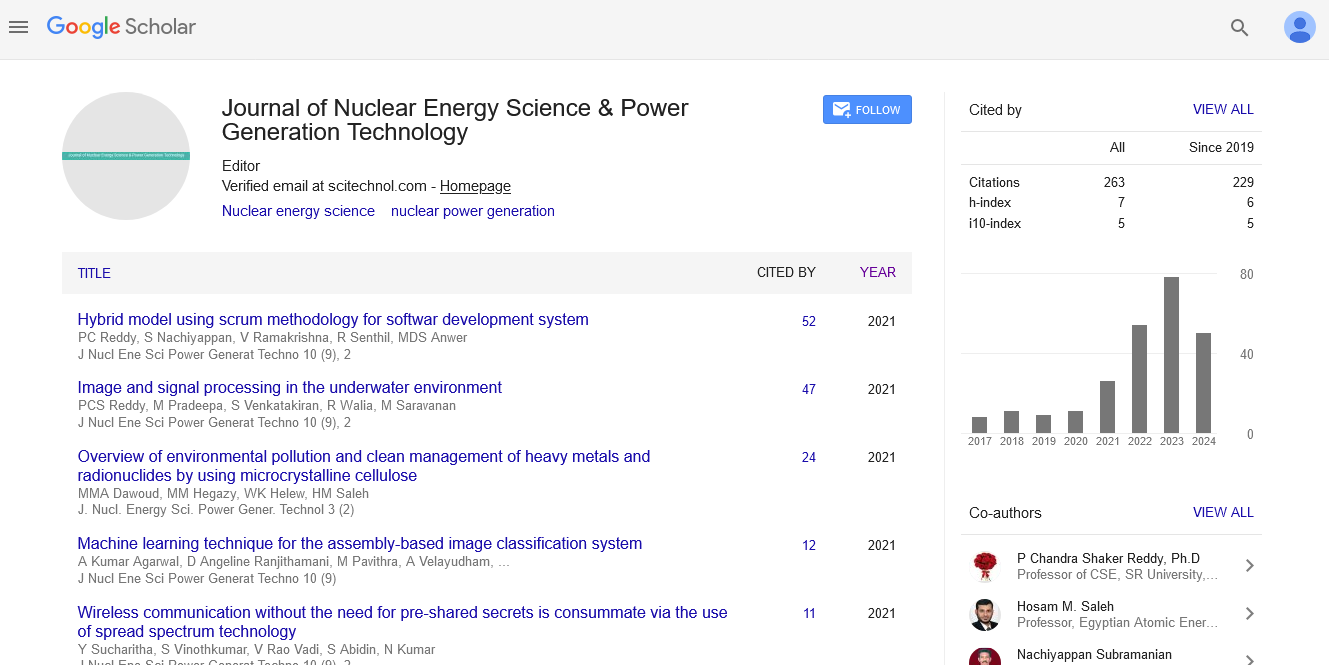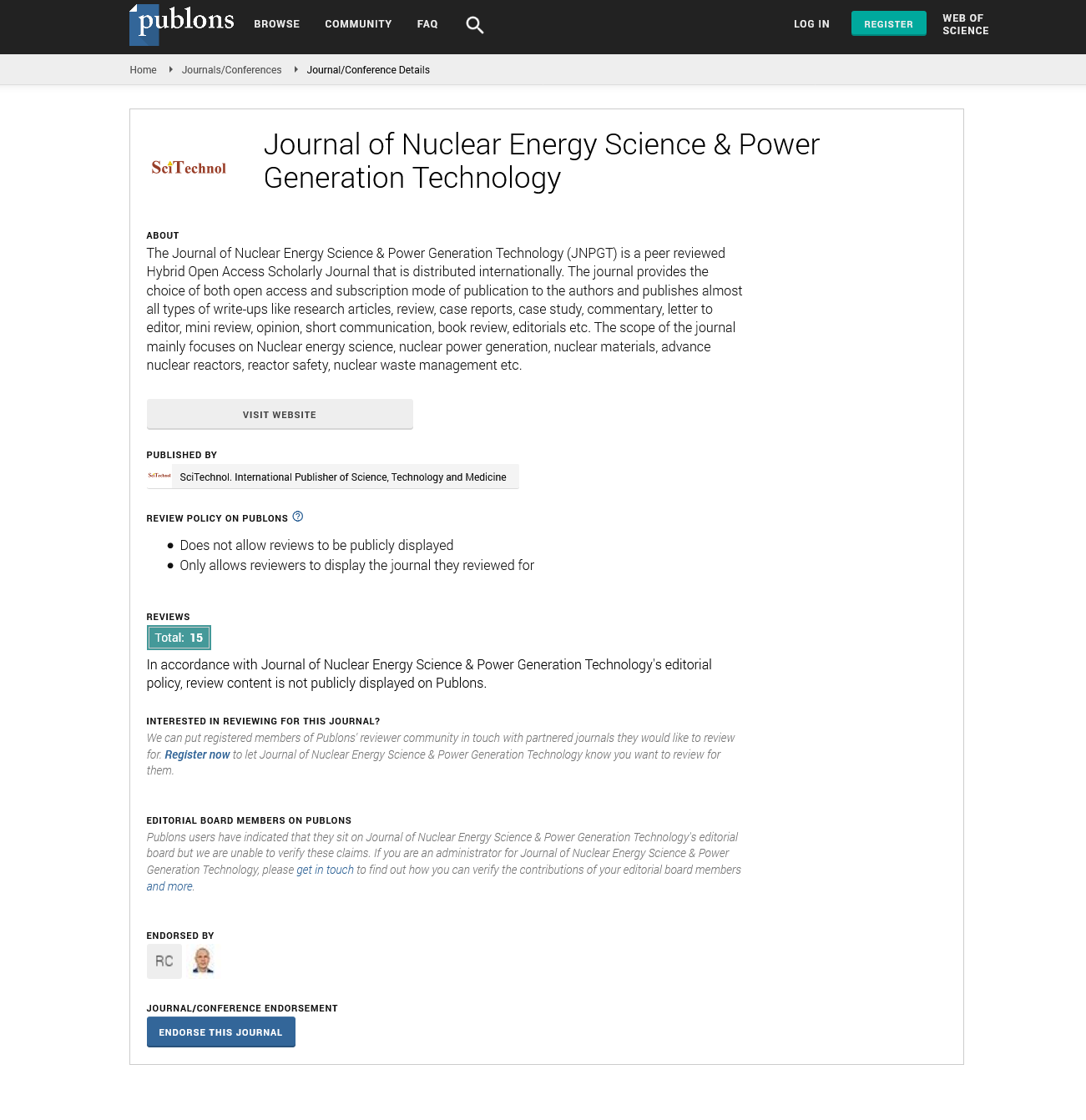Opinion Article, J Nucl Ene Sci Power Generat Technol Vol: 13 Issue: 5
Environmental Impact of TerraPower's Natrium Reactor
Trisa James*
1Department of Mechanical Engineering, University of Nevada, Las Vegas, USA
*Corresponding Author: Trisa James,
Department of Mechanical Engineering, University of Nevada, Las Vegas, USA
E-mail: trisa_james3456@gmail.com
Received date: 26 August, 2024, Manuscript No. JNPGT-24-150415;
Editor assigned date: 28 August, 2024, PreQC No. JNPGT-24-150415 (PQ);
Reviewed date: 11 September, 2024, QC No. JNPGT-24-150415;
Revised date: 18 September, 2024, Manuscript No. JNPGT-24-150415 (R);
Published date: 25 September, 2024, DOI: 10.4172/2325-9809.1000418.
Citation: James T (2024) Environmental Impact of TerraPower's Natrium Reactor. J Nucl Ene Sci Power Generat Technol 13:5.
Description
As global demand for cleaner and more sustainable energy grows, innovative solutions are redesigning the energy landscape. One of the most exciting developments in this field is Natrium reactor, an advanced nuclear technology that abilities to provide reliable, carbonfree energy while explaining the limitations of traditional nuclear power plants. The Natrium reactor stands out as one of the flagship projects, combining advanced nuclear design with integrated energy storage to produce a safer, more efficient and flexible power source. The Natrium reactor is a sodium-cooled fast reactor that is designed to operate at a capacity of 345 megawatts with the ability to boost output to 500 megawatts during peak demand periods. It incorporates a new energy storage system that uses molten salt, allowing the reactor to shift energy production in response to grid demands. By integrating energy storage, the Natrium reactor can help stabilize the grid, providing reliable energy when it is most needed.
At its core, the Natrium reactor uses liquid sodium as a coolant instead of water, which is typically used in traditional light-water reactors. Sodium’s higher boiling point and better thermal conductivity allow the reactor to operate at lower pressures and higher temperatures. This design not only enhances the overall efficiency of the reactor but also improves safety. Lower pressure reduces the risk of a catastrophic explosion, while sodium’s ability to absorb heat more efficiently makes the reactor less likely to overheat in an accident. One of the most significant advantages of the Natrium reactor is its improved safety profile. Traditional nuclear reactors rely on highpressure water cooling, which can lead to dangerous pressure buildups and potential reactor meltdowns in the case of system failure. By using sodium as a coolant, the Natrium reactor eliminates many of these risks. Sodium allows for passive cooling, meaning that in the occurrence of a shutdown, the reactor can cool itself without the need for active intervention, significantly reducing the likelihood of accidents.
Another important advantage is the reactor’s flexibility. The integration of molten salt energy storage allows the reactor to decouple electricity generation from nuclear fission. This means that the Natrium reactor can upgrade power generation when electricity demand is high and store excess energy when demand is low, releasing it to the grid as needed. This capability makes the Natrium reactor an ideal complement to renewable energy sources, enabling it to fill in the gaps when solar and wind power output drops. In addition, the Natrium reactor is designed to reduce waste. The sodium-cooled fast reactor technology enables the use of spent nuclear fuel from traditional reactors, which can be reprocessed and used as fuel in the Natrium reactor. This not only extends the life of existing nuclear fuel but also considers the problem of nuclear waste management, which has long been a contentious issue in the nuclear power industry.
While the Natrium reactor presents a promising vision for the future of nuclear energy, it is not without challenges. One major hurdle is the public perception of nuclear power. Despite its potential to provide carbon-free energy, nuclear power is often met with skepticism due to high-profile accidents like those at Chernobyl and Fukushima. Overcoming these concerns will require clear communication about the safety improvements in advanced reactors like Natrium.
Conclusion
Additionally, there are regulatory and financial barriers to widespread adoption. Building new nuclear reactors involves a lengthy and complex regulatory approval process, which can delay the deployment of new technologies. Natrium reactor represents a major advancement in nuclear energy technology. With its innovative design, enhanced safety features, integrated energy storage and ability to use spent nuclear fuel, it has the potential to revolutionize the way we produce electricity. As the world continues to transition toward cleaner energy sources, the Natrium reactor could play an important role in providing the reliable, carbon-free power that is essential for a sustainable future. However, overcoming regulatory, financial and public perception challenges will be important to realizing the full potential of this technology.
 Spanish
Spanish  Chinese
Chinese  Russian
Russian  German
German  French
French  Japanese
Japanese  Portuguese
Portuguese  Hindi
Hindi 

